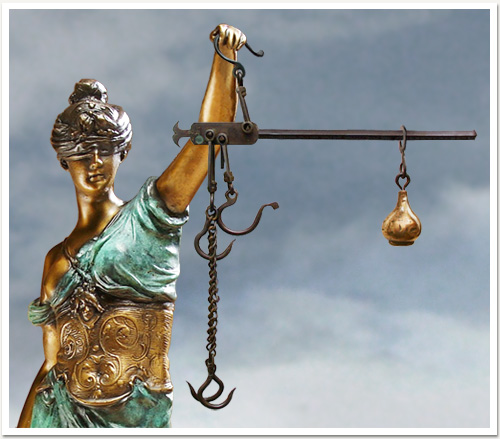Being born in October I have been, for most of my life, obliged to take notice of the balance. I am a Libra you see, and whatever else that does or does not portend for me as an individual, and whether or not that designation holds any meaning whatsoever for me personally, one result, impossible to deny, is that my brain has been conditioned from an early age to give special consideration, be it particular depth of thought or even a single extra second’s worth of attention, to scales.
When, as children, we first catch wind of the existence of astrological symbols we are at a point in our lives when anything which might help solidify our identities by differentiation is something deserving of our attention. Most of us, I would venture to guess, take hold of our symbol for some short interval as children, and wring whatever meaning we can out of it, drawing corollaries between ourselves and others who shared the same sign, taking heart in character traits supposedly attached, bolstering, through mythical means, our sense of ourselves. When later in our lives we reject astrology as fanciful and amusing hokum it hardly matters. Our signs are still there as the tiniest footnote at the bottom of our appraisals-of-self. We will always see in them the faintest reflection.
An analogy might be that of the lapsed Catholic, who was brought up going to church, but who on adulthood rejected religion outright. Catholicism was something born-into, something outside oneself, something not chosen but inherited. Even after a definitive choice is made to reject it, however, the symbol of a cross will always manage to successfully travel that guarded pathway to our interiors. Whatever judgement the brain passes that symbol will still hold sway with the eyes.
When I was in art school I was obliged, as all hopeful image-makers are, to re-examine the personal symbology of my life. Did any of the tired old symbols carry any weight or meaning? Could any of them be used, adapted, perverted? It dawned on me around that time that though I was fond of “The Balance” as a symbol ⊕, the equal-armed beam balance which is universally used seemed not quite right. This scale with its symmetry and elegance and precision could simply never be an accurate symbol for me, my mind, or the life that I lived. It was altogether too platonic.
A few years later while working, for a short time, as a security guard at the Metropolitan Museum of Art an alternative symbol presented itself. During a shift I was stationed in one of those wonderful, dimly-lit, and comparatively empty areas of the museum ⊕, beside some long glass cases containing Roman artifacts. There were small functional and decorative objects of all kinds inside —vessels and tools and little statues and amulets all jostling together like a the contents of Romulus’ hall closet.
Amongst all of this iron and bronze a single object seemed to demand further scrutiny. It was asymmetrical and brutal looking, with its dangling chains each terminating in a hook. I had no guess as to its function or purpose. Torture device? Weapon? Brutish tool of animal husbandry? Looking at its little placard I discovered it was called a “Roman Balance” or “Steelyard” and that it was in fact a scale. I marveled for a moment at the coincidence. Of all the objects to draw my eye and interest it had to be a scale. I knew immediately that I’d found an object I could get behind, an object which resonated with me somehow. I’d found a proper Libran symbol for myself.
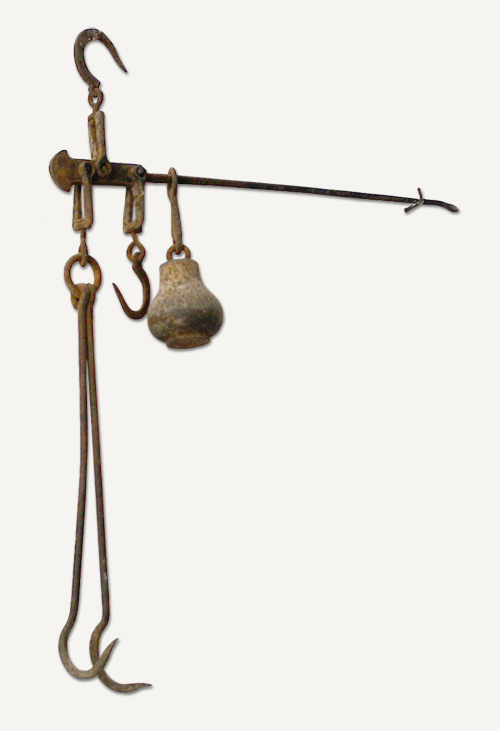
A bit of background information:
The Roman balance (or statera as it was originally known) is so called because no instance has been found of its existence prior to the Roman era. A similar principle was used in ancient Egyptian balances, however, and independently created examples have been found in China. Some evidence seems to exist that this type of scale was actually in use among Greek craftsmen in the Fifth and Fourth Centuries B.C.E. before Hellenistic mathematicians like Archimedes ever formally demonstrated the theoretic basis for their workings.
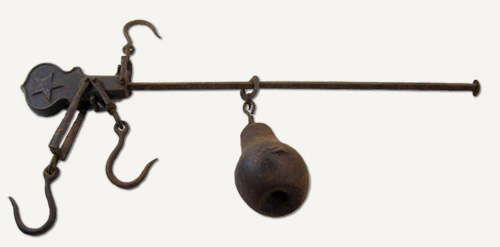
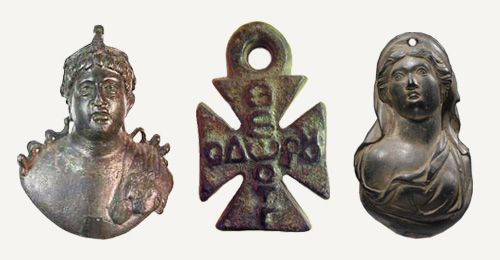
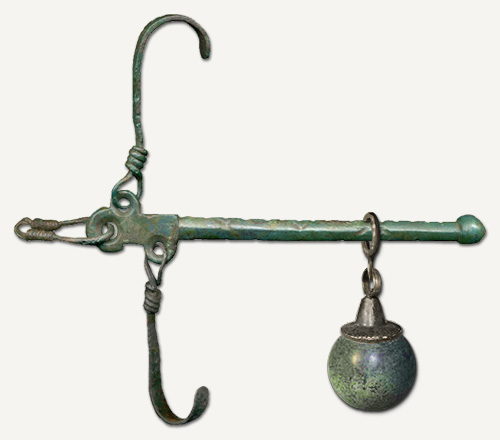
The Romans brought these scales to Britain around 55 B.C.E. and the English word ‘steelyard’ by which they are referred today is thought to be a mistranslation of the German ‘Stael-hof’ ⊕, which was itself the name of the base of the Hanseatic merchants of the Middle Ages, who used the Roman balance extensively in their businesses.
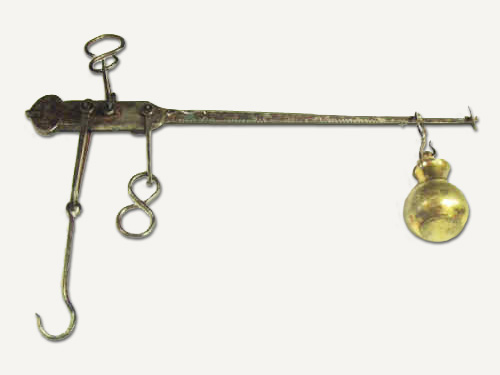
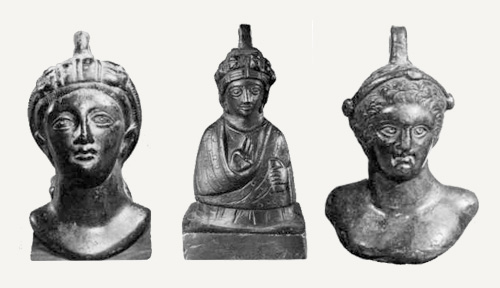
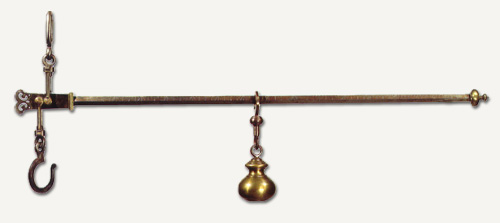
Functionally steelyards differ from the balance because they have unequal arms and employ a counterpoise, rather than a series of fixed-mass weights, which is shifted along the long arm in relation the the fulcrum. At the place where the counterpoise keeps the beam exactly horizontal, the weight of the object is indicated on an engraved scale on the long arm. ⊕
Though steelyards are less precise for weighing small objects like coins or jewels ⊕ they have the benefit of employing a single weight for a wide range of loads. They were particularly useful for weighing heavy objects like vehicles, sides of beef, and humans. Additionally they had the benefit of cheap manufacture and portability. In as much they were used as industrial scales straight through the eighteenth century and remain in use in markets all throughout Asia and and the Middle East today.
I happen to find them, with their precarious asymmetry, their hooks and chains and their myriad forms of sculpted counterweights quite compelling, and beautiful.
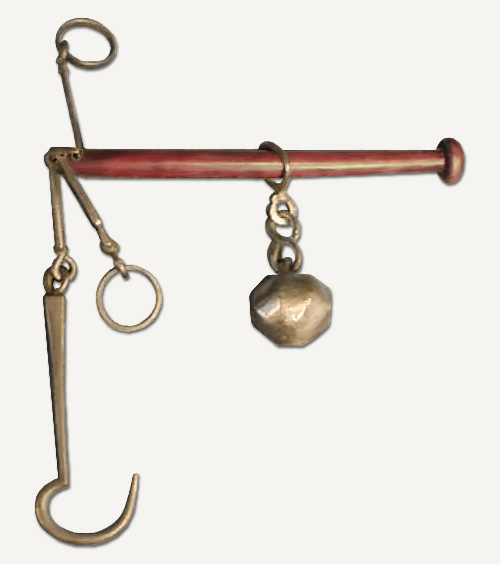
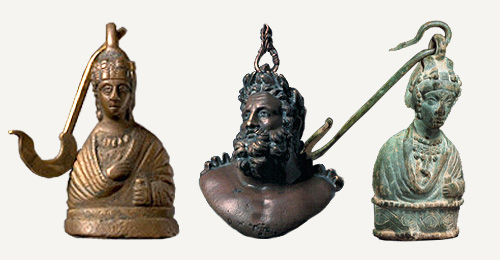
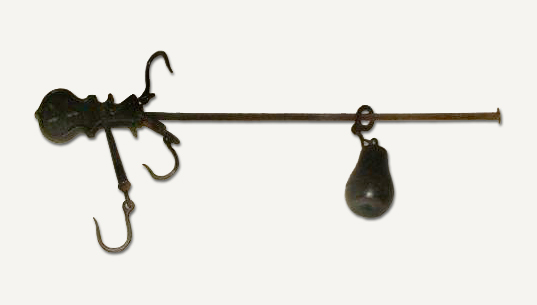
Visually, viscerally, the steelyard seems to embody some aspect of balance, or perhaps the personal quest for it, which the equal-arm balance does not. After having discovered it there at the Met I visited it often. It didn’t take me long to realize that this object had symbolic potential far beyond the whimsical introspection it might supply for the comparatively small group of us who were born under the sign of Libra.
What, after all, do the scales symbolize for the rest of humanity?
Thinking of the equal-arm balance, alone, in silhouette, or held aloft by the left hand of Themis / Justitia / Lady Justice, notions undoubtedly come to mind. They are precise and unambiguously immediate, aspirational and inspirational, they are resplendent and exalted, they are incorruptible and pure. In other words they have no relation whatsoever to the realities of human justice as it is experienced and met out.
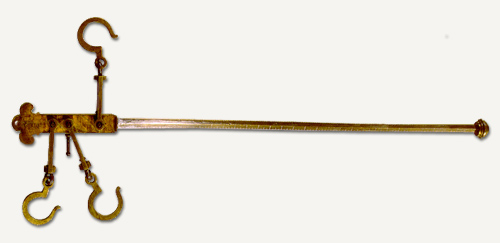
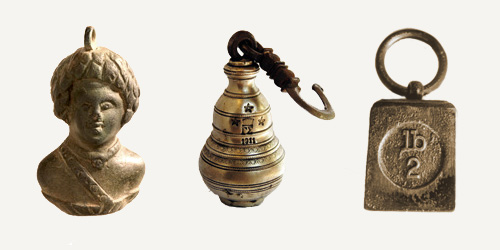
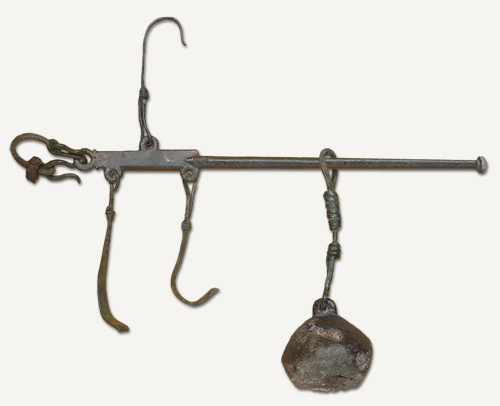
Now look at the steelyard. It is hard-looking and vaguely menacing, all hooks and chains and lengths of metal. It has a brutality to it somehow. You can imagine wielding it like a club or a flail and imagine the damage it might do were it wielded against you. Then there’s its asymmetry, which on first glance seems so counterintuitive to achieve any kind of balance. By design its sides are unequal, set against one another at cross-purposes. One side only holds the weight while the other only passes judgement, and a not quite precise judgement at that.
It’s a strange, hard, dangerous looking object, all angles and points set against a shifting bluntness, and one could imagine that were you to hand one to a child she’d be just as likely to smash in a skull as to balance anything whatsoever.
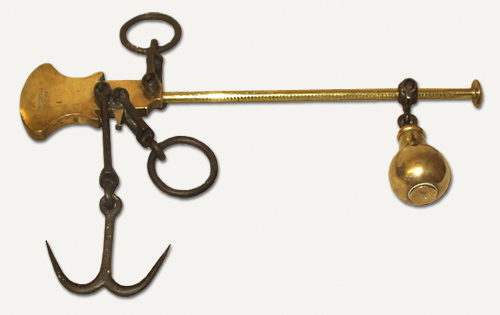
Though functionally the steelyard can achieve the same aims as our aspirational equal-arm scale, visually it suggests a complexity and precariousness and menace entirely more human, and I’d argue entirely more appropriate, symbolically, for our notions of crime and punishment, corporeal or otherwise. If a pound of flesh needs weighing this is the scale for the job.
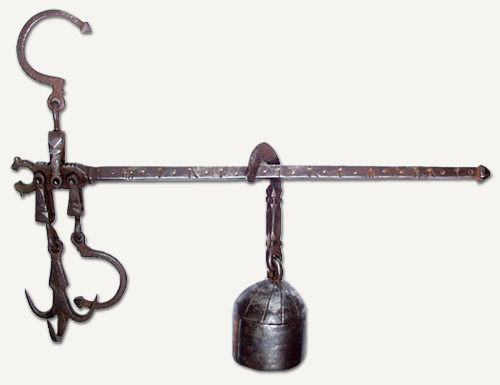
Add to this to the forms which the steelyard’s counterweight took, and could take, and all sorts of explicit symbolic relationships emerge. In the past these “poises” as they are sometimes called were often fashioned in the shape of gods, men, women or animals. One could easily imagine a slab of beef on the hooks counterbalanced by golden McDonald’s arches for instance, or an emaciated corpse counterbalanced by an Iron Cross, a knife counterbalanced by a black glove, a smoldering retarded child counterbalanced by a weight in the shape of Texas, a boot stamping on a human face, forever, counterbalanced by a giant silver dollar, or… well… whatever delightful image strikes your fancy!
The steelyard can do it all.
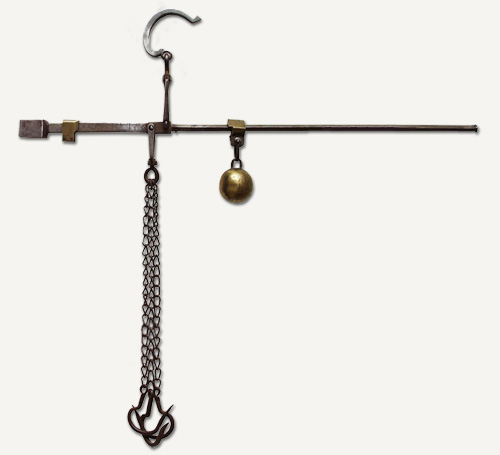
Anyhow, since happening upon that Roman balance about 12 years ago I’ve adopted it in my mind. When I think Libra I think steelyard, and so, conversely when I think steelyard I think, in some small way, of myself.
When I see a statue or etching of Lady Justice my mind reflexively erases that flimsy equal-arm balance with its impossible precision and imaginary exaltation and replaces it with its hard, practical, rough and ready, asymmetrical cousin. ⊕
Symbols are what they are, obviously, and not much more, but shouldn’t good ones reflect in some way the truth of a thing? Shouldn’t they hold their weight as it were? For me the steelyard does the job admirably and, yes, before you ask, even Nonists need symbols they can believe in.
Hope you enjoyed.
